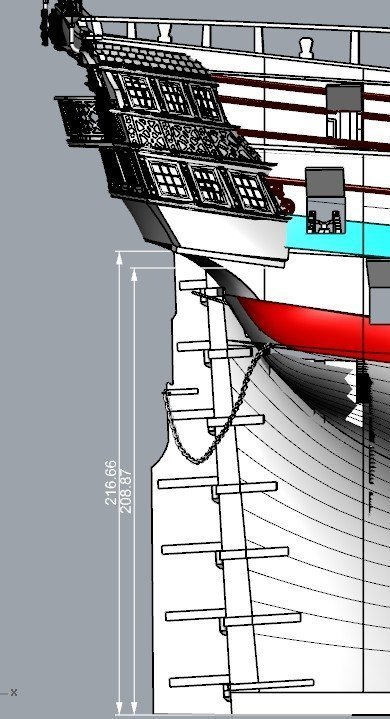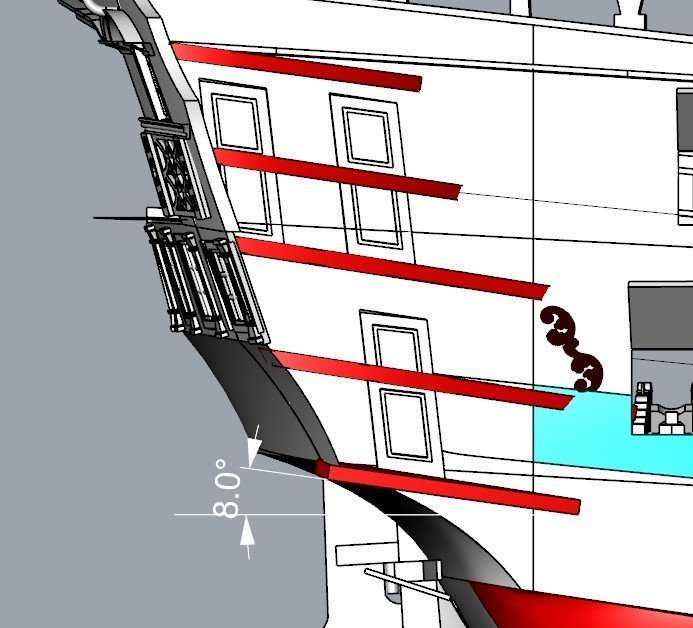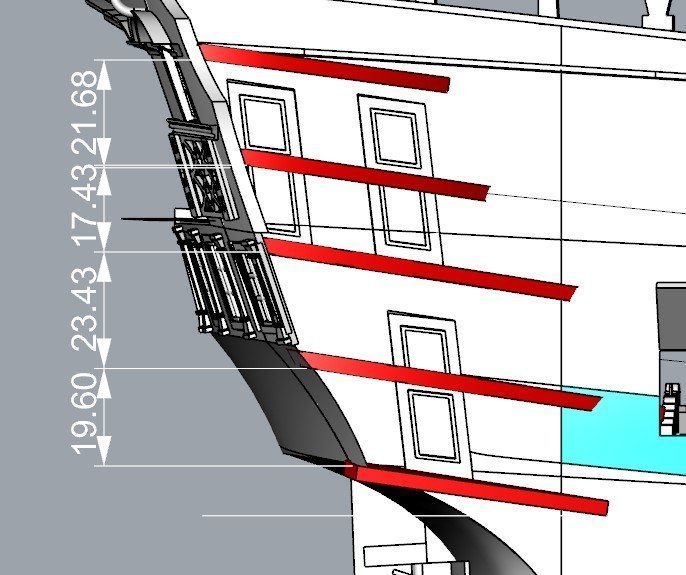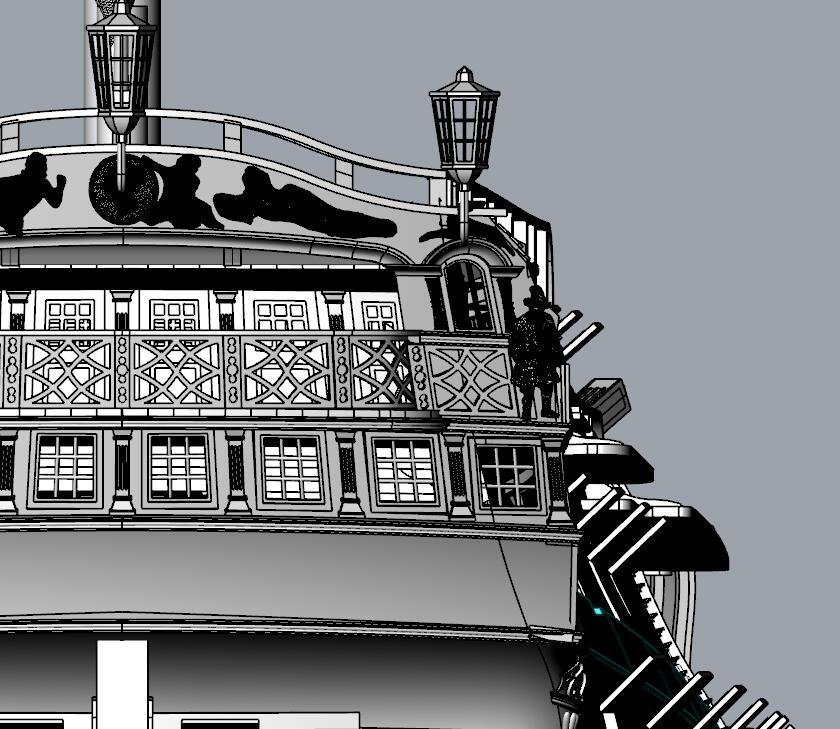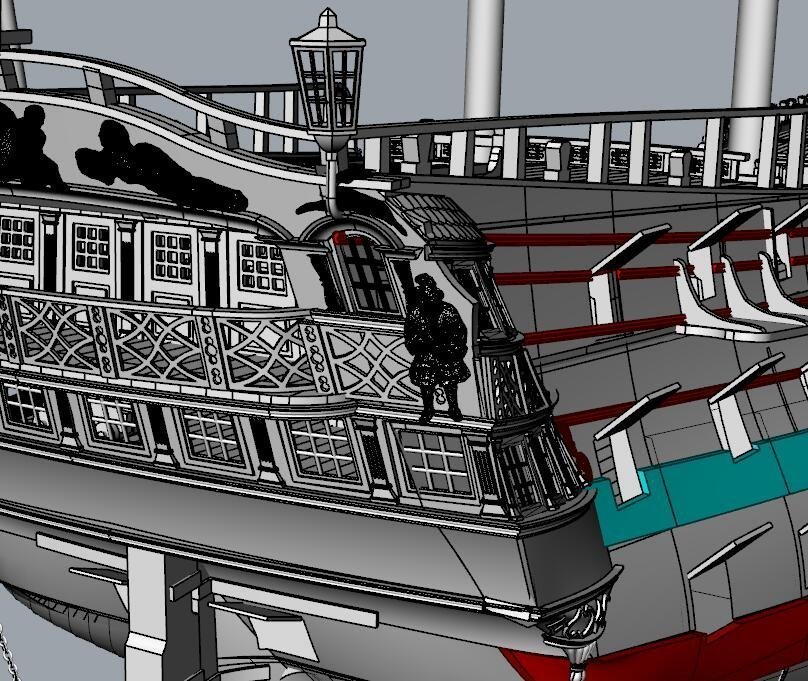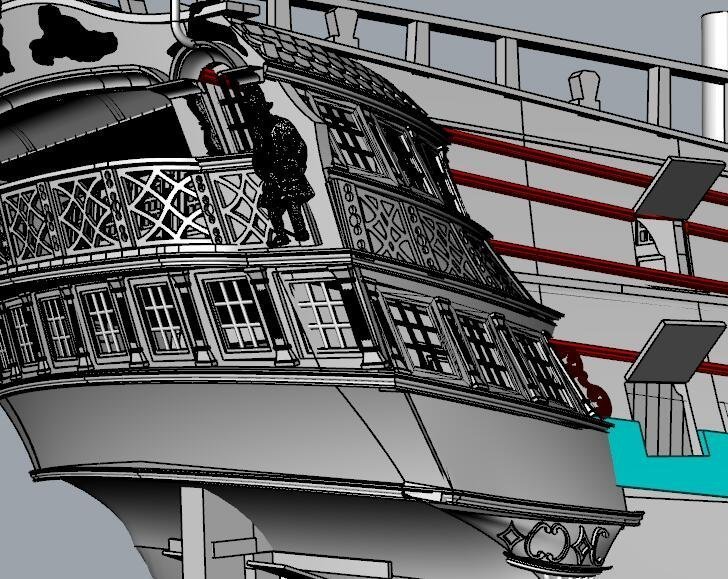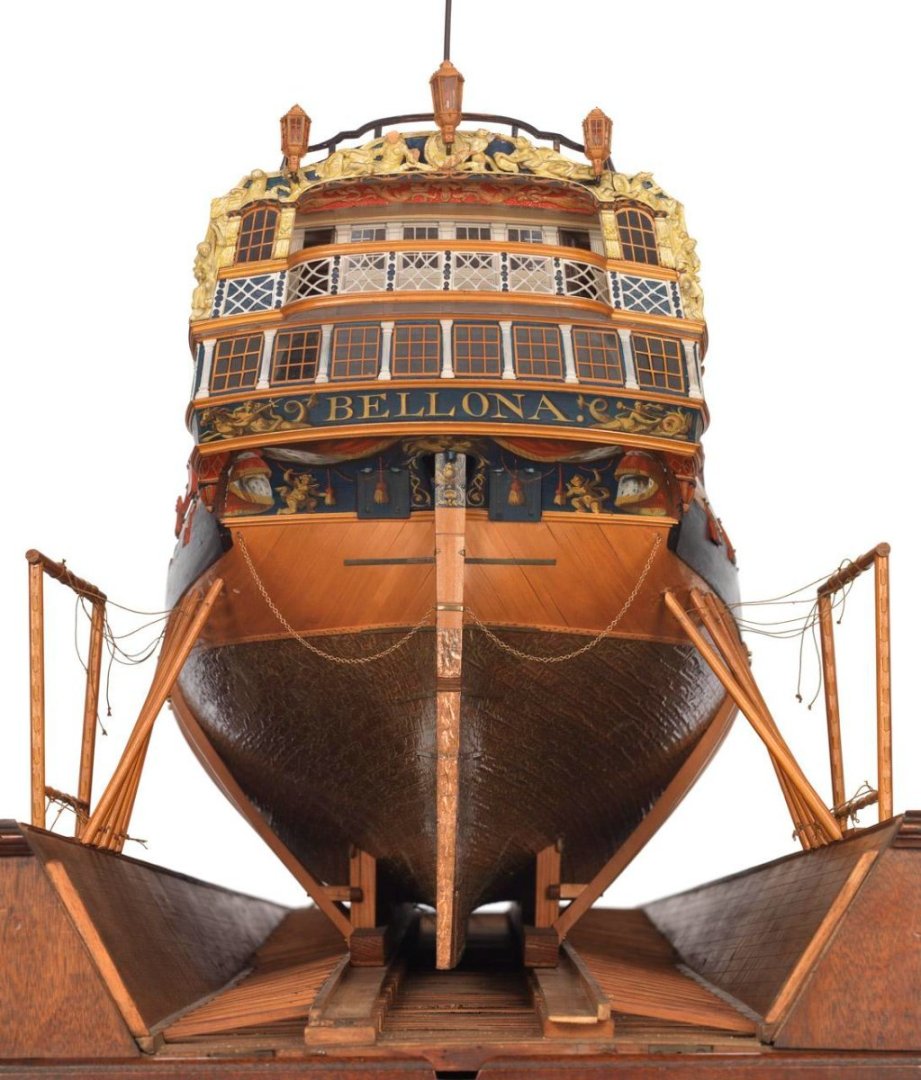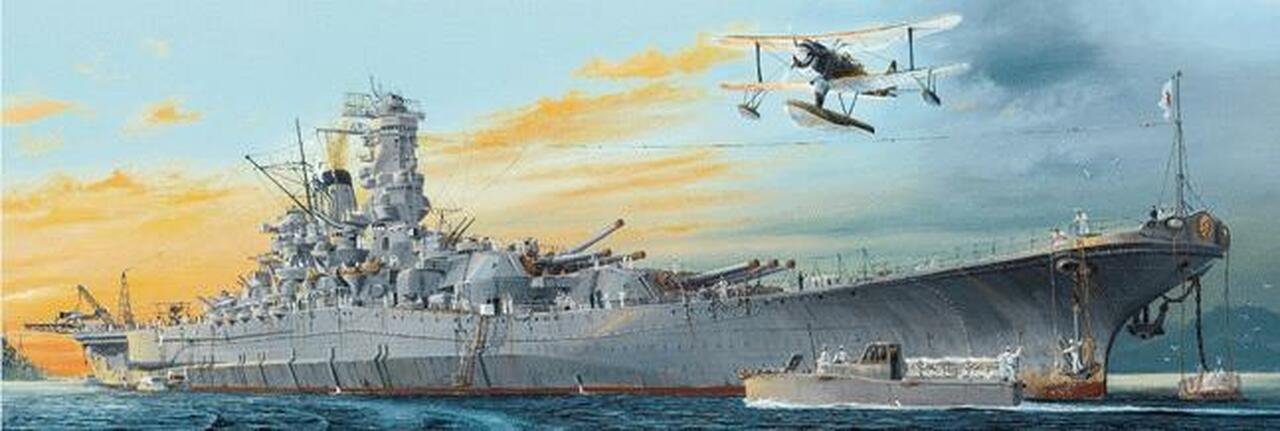-
Posts
3,589 -
Joined
-
Last visited
Content Type
Profiles
Forums
Gallery
Events
Everything posted by yvesvidal
-
A quick update on the Bellona: I am back working on the rear section of the main deck. This is a mix of Session #3 (Planking of the deck) and Session #4 (building of the ward rooms and officers rooms). The Section "D" is added to the front of Section "E", placing a lid on the six 32 pounders guns recently installed: You can see the axle of the rear capstan, protruding out of the deck. Planking is then continued: I am using strip of about 20 cm long (10 meters in real life) and I hope it is not too long for such period ships. I am also trying to replicate the four planks staggered arrangement, traditional of these vessels. The Captain's Pantry and Wardroom Pantry is glued to the deck: The deck (at least the rear section) is treated with three coats of Wipe-on-Poly to darken the planks and make them more resilient. You can see the difference of colors on the pictures. We are now moving to Session #4 (I am no longer following the order of the CAF instructions). This part is the assembly of the Officers' cabins, also called canvas cabins, as they were divided by removable pieces of canvas. The walls are strengthened by some strips of wood. The glass panes are made with tracing paper. Yves
-

MONTAÑES by Amalio
yvesvidal replied to Amalio's topic in - Build logs for subjects built 1751 - 1800
I love that rudder mechanism. So perfect and so realistic. Yves -
Time to go back to the Main and Gun decks: I have prepared six 32 pounders guns to install in the gun deck: The process is identical: Drilling the holes for the micro-nails, blackening of the barrels, tedious hand painting of the chassis and final assembly. The guns are resting on their four casters and a drop of CA glue is placed between the casters and the floor. The capstan is fully deployed and will be connected to the main deck Capstan, actually rotating both at the same time. From the outside, it is looking very ominous.... Now, I can resume the work on the main deck, at least towards the poop. Yves
-
Yes, I do. I am using Future Floor (Pledge) before (2 coats) and after (2-3 coats). It is a tiny bit shiny at first, but the luster goes away after a few days and after gliding my fingers on the decals. You can see the Pledge bottle on some of the pictures. Decals are installed using Microscale-SET and SOL concoctions. Yves
-
With all these spare parts, I am starting to wonder if buying the kit is really necessary..... 🙂 Yves
- 203 replies
-
- Roma
- Micromaster
- (and 4 more)
-
The carving (CNC ?) of this wood panel is amazing. I wish CAF Model could consult with you.... and improve their parts. Yves
- 488 replies
-
- Indefatigable
- Vanguard Models
-
(and 1 more)
Tagged with:
-
Beautiful model. Thank you for presenting your Build Log. Yves
- 35 replies
-
- Artesania Latina
- Sultan
-
(and 1 more)
Tagged with:
-
Tom of CAF Models was kind enough to send me some additional pictures to help the stern construction. They came a little bit late, as I had already started. I wish these pictures could have been included into the original instructions booklets: And of course, the famous National Gallery model, source of inspiration for the CAF Model kit: I used that picture a lot for the decals placement and the overall shaping of the stern. There are some mis-labelling for the decals, in the CAF instructions (Session #5). Beware..... Yves
-
Time for another update. I have been working on the galleries and the decoration of the stern. It is very delicate work despite the use of 1/48th scale, due to multiple factors: The instructions are less than adequate and bring no precision to what has to be built. The parts are not exact in shape and dimensions. Because of these factors, a lot of research, creativity and building have to take place. Let's take a quick look at the instructions: I started with the installation of the balcony. This is essential in placing correctly both galleries (I am no longer following the CAF instructions overall). The balcony is delicately cut from the quarterdeck floor, and put in place separately. I have verified that the flooring of the quarterdeck will align and match perfectly with the balcony floor. This phase is essential to position correctly the rear wardroom lights and the upcoming pilasters. Below, you can see the quarterdeck floor in place: The wardroom lights framing is then glued in place: At this point, the galleries construction can be started. A lot of adjustments have to be done and quite a few parts were created, as I decided to not use the kit supplied parts, that are not fitting. After a lot of precise adjustment and work. Above, you can see how I increased the size of the 3D-8 parts, by adding four strips of 3x2 mm all around it.. Finally, we end up with something that looks like the stern of a Bellona: At that stage, we can start gluing the counter rails: And place a few decals. It is now coming to life: The wardroom lights will be installed later on as they are extremely delicate (carved in wood) and I still need to adjust the top fascia of the stern. For the time being let's enjoy some pictures of that delicate stage of the construction: I have added the "dot" after the name of the ship, as it was missing from the decal. The "drops" are made from resin (3D printed) and do require some filing to fit decently. Yves
-
You will have to start a new Build Log, when you decide to tackle the kit. Yves
- 454 replies
-
- Union Steamship Company
- Stepcraft 840
-
(and 3 more)
Tagged with:
-
I share your torments. I started thinking if it was worthwhile installing them on my model as well. I even went down the path of purchasing the Longboat kit from Syren, to install on top of these beams.... If I was you, I would leave the beams bare and would remove the cradles. They distract the eyes and ruin the purity of the Navy Board style model you are trying to achieve (and succeeding at it). Yves
- 857 replies
-
- Sphinx
- Vanguard Models
-
(and 1 more)
Tagged with:
-
It reminds me of some difficult and delicate phases during the planking of my Bellona. The wood was softer on the Bellona kit, but it still required a lot of heavy tools to make it bend and stay in place. You are doing a great job, Kenny. Yves
- 1,124 replies
-
B.E. your model is an endless source of marvels for me. You are pushing the perfection towards new boundaries. Yves
- 857 replies
-
- Sphinx
- Vanguard Models
-
(and 1 more)
Tagged with:
-

1/200 Trumpeter IJN YAMATO - issued by MRC/Gallery Models
yvesvidal replied to yvesvidal's topic in REVIEWS: Model kits
The rigging is never indicated by Trumpeter. It is typical of them and they don't care. Obviously, additional reference books will be required to turn this model into a realistic model. Yves- 104 replies
-
- MRC/Gallery
- Yamato
-
(and 1 more)
Tagged with:
-
That is surprising from Trumpeter. I was looking at the Yamato 1/200 hull, which is made of two parts. Because of the aluminum bracing that is securing the two halves, it is hard to see the junction. If you don't pay attention, you would think the hull was molded of one part. I wonder if ROMA is an old kit..... Maybe it was done by a different team. Yves
- 203 replies
-
- Roma
- Micromaster
- (and 4 more)
-

1/200 Trumpeter IJN YAMATO - issued by MRC/Gallery Models
yvesvidal replied to yvesvidal's topic in REVIEWS: Model kits
Joshua, There may not be a discussion about this topic on that forum, but the consensus is that the old Nichimo kit was showing its age and that plastic injected models have made so many progress recently, that the old kit would not compare too favorably. FUJIMI introduced a complete revamp of the superstructure and guns of the Nichimo kit, and that helped a lot modernizing/improving the original kit. I suspect that the Nichimo kit requires a lot of extra work to turn it into a scale model as it was developed to navigate, before all. Most likely, PONTOS, MK and a few others will be offering add-ons and PE kits for the YAMATO in 1/200 scale. That will give you access to a vast pool of parts if you decide to build or improve your Nichimo kit. Yves- 104 replies
-
- MRC/Gallery
- Yamato
-
(and 1 more)
Tagged with:
-

1/200 Trumpeter IJN YAMATO - issued by MRC/Gallery Models
yvesvidal replied to yvesvidal's topic in REVIEWS: Model kits
Chris, the box is gigantesque ! Just make sure that your better half is away when it arrives at your home. :-) Yves- 104 replies
-
- MRC/Gallery
- Yamato
-
(and 1 more)
Tagged with:
-
"Alea Jacta Est" as the Romans used to say: The stern section of the ship has been covered with the main gun, and no access to the large guns is possible in this area: You can see how the Main deck section "E" had to be altered to fit the hull: Now, I will be working on the Quarterdeck positioning and hopefully get a clearer picture of the stern ornaments and galleries. Yves
-
Folks, this is the kit that many many many modelers have been waiting for a very long time: a replacement for the old and so incorrect NICHIMO kit of the 1/200 YAMATO legendary Japanese battleship. When I started receiving offers to pre-order that model, I jumped on it. I had always considered getting the NICHIMO kit plus the additional FUJIMI kits to improve it but was turned off by the prices. Today, we have a much better substitute thanks to Trumpeter and MRC/Gallery Models which are distributing this massive model on the Western market. I pre-ordered my kit from Squadron for $579, free shipping, no taxes. The kit was made available on June 14th in the USA and was at my door on the 16th. It cannot be better. After a quick look at the kit, I would say that it is a very impressive work, only missing one thing: the wooden decks and perhaps metal guns. Those are already made available by Scaledeck apparently and I am sure the usual PONTOS and MK folks will jump on the bandwagon to add countless details to this 2800 parts kit. I am not an expert of YAMATO and thus, I will limit myself to presenting the kit. It comes in a very large and beautiful box (Trumpeter style), with gorgeous artwork: No mention of Trumpeter can be found on the box or any included literature, but for those who have built Trumpeter kit, it makes no doubt that it is their creation. Inside the kit, we have 7 separate boxes, packed to the hilt: The Assembly manual is 117 pages long: A nice color sheet is also included with decals for the ship and the planes: Let's jump into each one of the seven boxes: This one is fully packed and contains most of the superstructures: Box B contains the guns and all the PE parts: I am not showing all spruces as there are way too many to display. Box D contains the two decks pieces: Box E is dedicated to anti-aerial defense: Finally, the last and biggest box is the massive 5 foot long hull, cast in two parts. The two halves are secured to each other with aluminum parts and plastic parts and provide a very strong and precise alignment. This is it for now. I have placed everything back in the box and will perhaps start a Build log one day. I did not want to miss on that kit, which I am sure will quickly become rare and coveted. I hope you have enjoyed that quick introduction. There are a few beautiful implementations of this ship on the forum that can be used as a guide for improving on the kit. I know that I will be using RGL's build log of his gorgeous 1/350th Yamato for my reference, when the time comes to build that monster. Yves
- 104 replies
-
- MRC/Gallery
- Yamato
-
(and 1 more)
Tagged with:
About us
Modelshipworld - Advancing Ship Modeling through Research
SSL Secured
Your security is important for us so this Website is SSL-Secured
NRG Mailing Address
Nautical Research Guild
237 South Lincoln Street
Westmont IL, 60559-1917
Model Ship World ® and the MSW logo are Registered Trademarks, and belong to the Nautical Research Guild (United States Patent and Trademark Office: No. 6,929,264 & No. 6,929,274, registered Dec. 20, 2022)
Helpful Links
About the NRG
If you enjoy building ship models that are historically accurate as well as beautiful, then The Nautical Research Guild (NRG) is just right for you.
The Guild is a non-profit educational organization whose mission is to “Advance Ship Modeling Through Research”. We provide support to our members in their efforts to raise the quality of their model ships.
The Nautical Research Guild has published our world-renowned quarterly magazine, The Nautical Research Journal, since 1955. The pages of the Journal are full of articles by accomplished ship modelers who show you how they create those exquisite details on their models, and by maritime historians who show you the correct details to build. The Journal is available in both print and digital editions. Go to the NRG web site (www.thenrg.org) to download a complimentary digital copy of the Journal. The NRG also publishes plan sets, books and compilations of back issues of the Journal and the former Ships in Scale and Model Ship Builder magazines.





